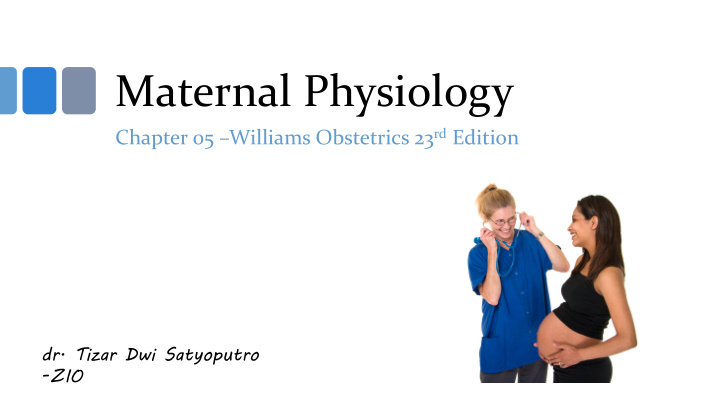



Maternal Physiology Chapter 05 – Williams Obstetrics 23 rd Edition dr. Tizar Dwi Satyoputro -ZIO
Physical adaptations during pregnancy
Anatomical and functional changes • Metabolic Changes • Hematological Changes • Reproductive Tract • Respiratory Tract • Gastrointestinal Tract • Cardiovascular System • Urinary System • Endocrine System • Breast Changes
Metabolic changes Carbohydrate metabolism Weight gain Water metabolism
Clotting factors: hypercoagulable, throboembolism Hematological changes Fibrinogen (factor I) +50% (4.5 vs 3 g/L) Factor VIII increase Blood volume (polymorphonuclear) +40% Factors VII, IX, X and XII increase Dilutional anemia Hb 110 g/L Prothrombin time, PT shortened Leukocytosis 15,000/ m l ATPP activated partial thromoplastin time shortened Platelet not change Fibrinolytic activity decrease Sedimentation rate increase, 100m/h Iron turnover Coagulation & Fibrinolysis Blood volume
Weight : 70 g ( before pregnancy ) – 1100 g ( during pregnancy ) Volume : 5 L to 20 L or more – 2500 L to 5000 L or more Shape : pear ( beginning ) spherical ( 12w ) ovoid Reproductive Tract Uterine contractions : intensity 5 and 25 mm Hg; frequency 10 to 20 minutes (near term) Uteroplacental Blood Flow : 450 to 650 mL/min near term Appearance : Violet regulation: estradiol and progesteron administration to color characteristic of modify vascular resistance Chadwick sign. Wall : increase in mucosal thickness , Shape : pronounced softening and cyanosis (1m after loosening of the conception ) Increased vascularity and edema , connective tissue , hypertrophy and hyperplasia of the cervical glands and hypertrophy of Containment : >50% of cervical mass cervical glands ( end smooth muscle cells of pregnancy ) pH : 3 to 6 ( acidic ) Cervical mucus : soon after conception, acts as immunological barrier Progesterone production : a single corpus in pregnant women (max. 6w to 7w of pregnancy – 4w to 5w postovulation) Diameter of ovarian vascular : 0.9 cm to 2.6 cm ( at term ) Musculature of the fallopian tubes : a little hypertrophy (during pregnancy) Fallopian tube torsion : increasing size of the gravid uterus
Respiratory Tract • Mucosal hyperemia • Subcostal angle • Chest circumference and diameter • Diaphragmatic excursion • Tidal volume +30-40% • PO2 is increased, PCO2 is decreased. • Total lung capacity decrease -15% • Minute ventilation +30-40% • Mild respiratory alkalosis
Gastrointestinal Tract • Morning sickness • Hyperremesis gravidarum (weight loss, ketonemia and electrolyte imbalance) • Dietary craving: pica • Decreased gastrointestinal motility: reflux and heartburn • Gallbladder function, cholestasis • Hyperemia and softening of the gums (epulis) • Hemorrhoid • Appendix displaced
Cardiovascular System Cardiac outline: The blue lines represent the relations between the heart and thorax in the nonpregnant woman, and the black lines represent the conditions existing in pregnancy Circulation & Blood pressure Blood volume +30% Stroke volume +30% Heart rate +15% Plasma volume +40% Cardiac output +40% Red blood cell volume +20% Oxygen consumption +20% Dilutional anemia SVR (systemic vascular resistance) -5% Systolic BP -10mmHg Increase cardiac output Diastolic BP -15mmHg Decrease blood viscosity Mean BP -15mmHg Vasodilatation Cardiac output Right shift oxyhemoglobin dissociation curve
Urinary System GRF – ERPF – Filtration fraction Protein excretion
Endocrine System Thyroid Glands Andrenal Glands: Cortisol Thyroid physiology
Breast changes • Engorgement and venous prominence Increase in size by 2 nd mo – hypertrophy of mammary alveoli • Tenderness and tingling occur in early weeks of pregnancy Mastodynia (breast ternderness): tingling to frank pain caused by hormonal responses of the mammary ducts and alveolar system • Nipples become larger, more deeply pigmented, more erectile Colostrum , a thick yellow fluid can be expressed from the nipples, may be expressed by the 2 nd trisemester • Montgomery’s tubercles : enlargement of circumlacteal sebaceous glands of the areola
Thank you!
Recommend
More recommend